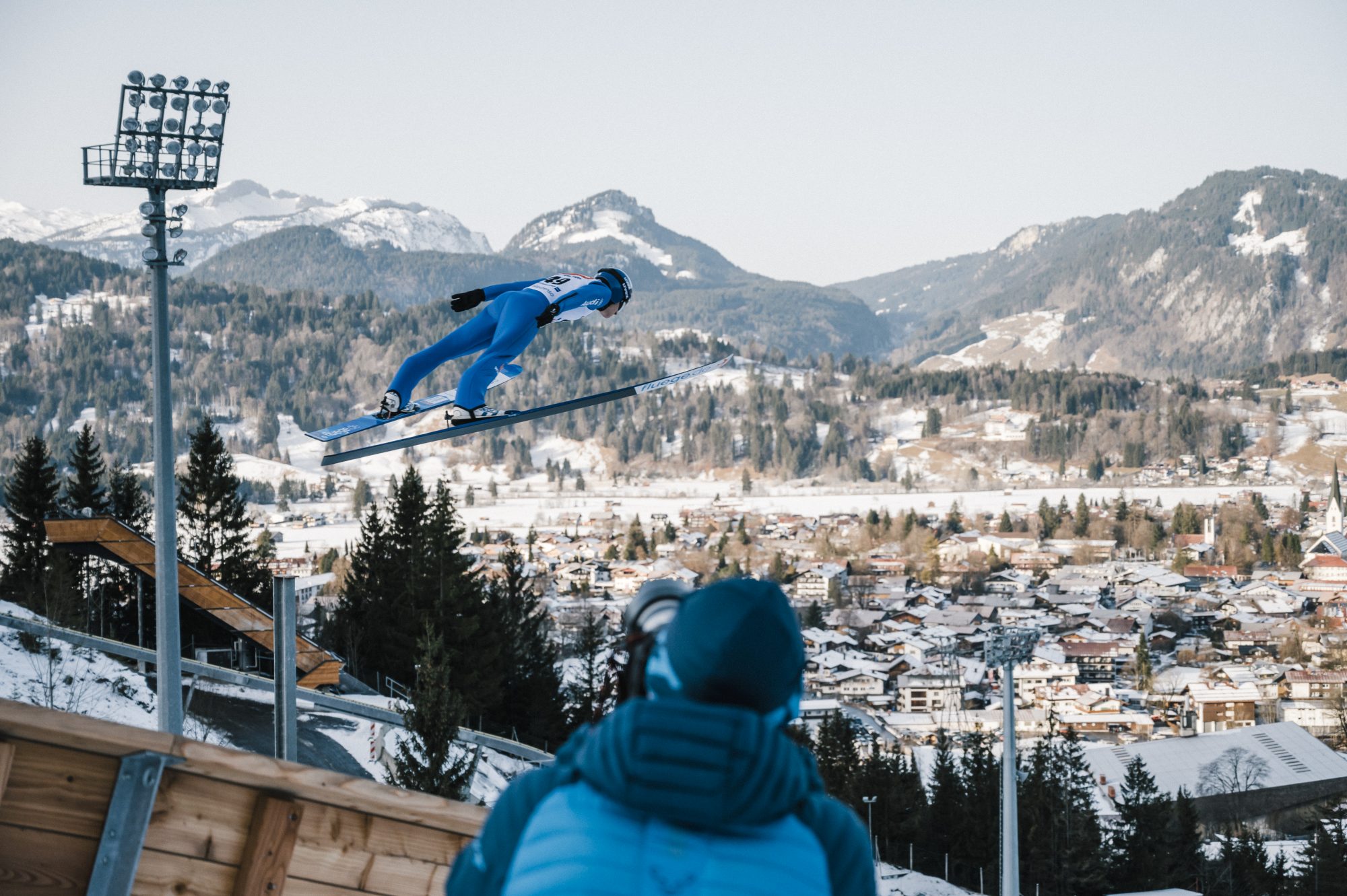The World’s best ski jumpers and cross-country skiers have gathered in Oberstdorf, Germany, at the Nordic Ski World Championships. However, one of the leading parts is played by an experienced meteorologist. Joachim Schug from DTN knows a thing or two about the perils awaiting the host and the athletes between mountains and valleys.
Some sports need proper wind to be fun. Sailing, for example, or windsurfing. For ski jumpers, a strong wind gust may not only make the difference between victory and defeat but also between life and death. Therefore, organizing a ski jumping event is a highly responsible task. Essential support comes from professional meteorologists, who help organizers to make important and often very rapid decisions. When will the wind calm down? Is a storm approaching? Do we have to postpone or even cancel the event?
A Lufft WS600 weather sensor next to the jump-off platform
At the Nordic Ski World Championships, that have started last Wednesday, it is Joachim Schug from DTN (formerly MeteoGroup Schweiz AG) assuming that role. Born in Sonthofen, only a few kilometers north of Oberstdorf, Joachim Schug has to follow the event from his home in Appenzell, Switzerland, due to pandemic-related travel restrictions. Remote support increases the need of absolutely reliable weather data from the event itself. In Oberstdorf, this data is provided by a Lufft WS600 weather sensor.
The weather sensor belonging to the local skiing club SC Oberstdorf is placed right next to the jump-off platform. Taking off with over 90 kilometers per hour (close to 60 mph) is a key moment during the jumping process – which feels like flying with distances of around 140 meters (around 460 ft). Especially relevant parameters for ski jumping are wind speed and direction. Since they can push or hamper a jump, these two parameters directly impact the rating: updraft allows for higher jumping distances and comes with a point penalty, whereas crosswind and tailwind add points to the rating. In addition to the Lufft WS600, the organizers use six further anemometers along the ski jumping hill to keep the whole jumping lane firmly in view.
Meteorological support of major events is a rapidly growing business area for DTN. In addition to sporting events the weather service provider supports music festivals like the Wacken Open Air. This discipline is called event weather. „More and more organizers are running their own weather stations,” Joachim Schug says. He often recommends weather sensors of the Lufft WS series. “Locally limited weather events as storms have a significant impact on the microclimate at the location itself, where the weather conditions can vary extremely from the surrounding weather stations operated by national weather services.”
Event weather is a growing business area
In mountain areas, usually the home of winter sports, monitoring the microclimate at the very location is particularly important. “Organizers often ask very detailed questions that even the newest algorithms do not know the answer to,” Joachim Schug says, who was asked lots of nearly prophetic questions in his long career. These included the following: “When will the fog go away? Will there be more than 0.5 cm of snow within the next ten minutes? Is the wind getting stronger or was this only a wind gust caused by the shock wave of a close avalanche?”
Organizers often ask very detailed questions that even the newest algorithms do not know the answer to.
Joachim Schug, MeteoGroup Schweiz AG
In alpine skiing races as the Slalom World Cup in Adelboden, Switzerland, other meteorological parameters are important, too. To measure the snow height at the starting hut where the athletes begin their descent, the organizers installed a snow height monitoring sensor Lufft SHM31. “Thanks to this device, the organizers know early if they have to mobilize additional staff to prepare the track,” Joachim Schug says. Visibility is another relevant parameter. On foggy days, organizers paint blue lines on the snow to lighten orientation. In cases of very dense fog, the race has to be canceled. “If the fog is sticking to a mountain, a common phenomenon, satellite images or simulation models cannot provide reliable conclusions,” Joachim Schug says. “In such cases you have to observe how the wind behaves along the valley. If it is continuously pouring in into the valley, the fog cannot escape. Then, I cannot raise the organizers’ hopes to start the race.”
From a meteorological point of view, cross-country skiing is less complex. Usually, DTN provides two to three weather forecasts per day including air temperature, air pressure, relative humidity, wind, and precipitation. Crucial for cross-country skiing is the snow temperature because it impacts the gliding properties of the skis. “The teams tend to measure the snow temperature on their own and wax the skis according to their requirements and preferences,” Joachim Schug says – a science in itself.
Spring weather bothers athletes and organizers
Now, an early wave of spring has found its way into Allgäu, the region of Oberstdorf in the southwest of Bavaria. Ten hours of sunshine and temperatures of over 15 degrees Celsius (around 60 °F) challenge both athletes and organizers, as Joachim Schug explains: “Especially the springlike temperatures and the strong solar irradiance cause problems. The organizers and athletes look forward to the weekend that, according to our forecasts, should bring clouds and a bit of precipitation – but first and foremost lower temperatures.”
As a quick reaction, the organizers have rescheduled some competitions from lunchtime to the early morning. Short-term measures like this show the growing importance of experienced meteorologists and reliable sensors for major events. Therefore, Joachim Schug sees high potential when weather services like DTN and manufacturer of monitoring systems like OTT HydroMet with its brand Lufft join forces.
Photo by Dominik Berchtold




